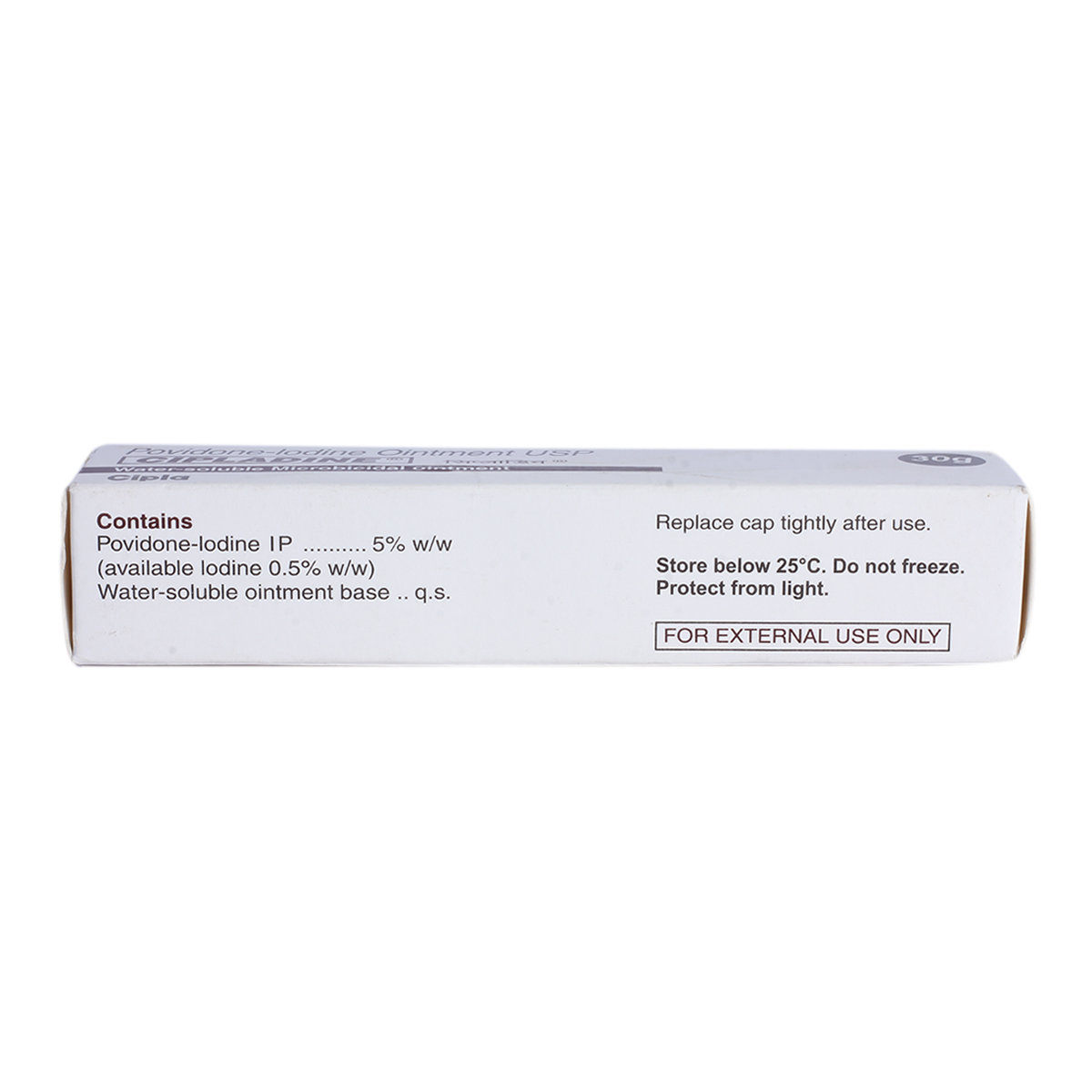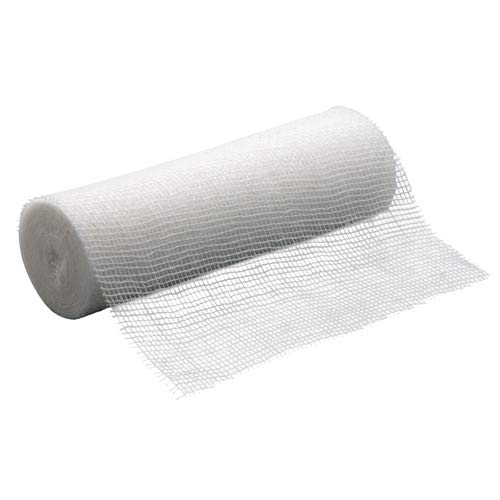Cipladine 5% Ointment 30 gm
MRP ₹98.5
(Inclusive of all Taxes)
₹14.8 Cashback (15%)
Selected Pack Size:30 gm
30 gm ₹88.7
(₹2.96 per gm)
In Stock
125 gm ₹173.3
(₹1.39 per gm)
In Stock
20 gm ₹54.9
(₹2.75 per gm)
In Stock
10 gm ₹28.6
(₹2.86 per gm)
In Stock
15 gm ₹44.2
(₹2.95 per gm)
In Stock
About Cipladine Ointment
Cipladine Ointment belongs to the class of 'antiseptics and disinfectants' primarily used to treat common skin infections. It treats and prevents skin infections in minor burns, lacerations (deep cut in the skin), cuts, and abrasions (the first layer of skin is scraped off). Skin infection occurs when foreign microorganisms like fungus or bacteria invade the skin and affect the tissues.
Cipladine Ointment contains Povidone Iodine. It works by inhibiting the growth of infection-causing microbes. As a small molecule, iodine can easily penetrate microorganisms and oxidizes essential proteins, nucleotides, and fatty acids, leading to cell death. Cipladine Ointment is effective against bacteria, fungi, viruses, and protozoa.
Cipladine Ointment is for external use only. Cipladine Ointment may cause common side effects like red or inflamed skin, peeling skin, dry skin, and irritation at the application site. These side effects gradually resolve during the treatment and do not require medical attention. However, if the side effects persist longer, please seek medical help.
Brief your medical history to the doctor if you are allergic to iodine or povidone. Let your doctor know if you have thyroid diseases, liver, and kidney problems before starting Cipladine Ointment. Please tell your doctor if you are undergoing any lithium therapy or radioactive iodine treatment. Do not use Cipladine Ointment before or after radioiodine scintigraphy or radioiodine treatment of thyroid carcinoma. Please consult your doctor if you are pregnant, planning to conceive or are a lactating mother before using Cipladine Ointment.
Country of origin
Manufacturer/Marketer address
Online payment accepted

secured payment

india's most trusted pharmacy

genuine products
Composition :
Manufacturer/Marketer :
Consume Type :
Expires on or after :
Return Policy :
Provide Delivery Location
About Cipladine Ointment
Cipladine Ointment belongs to the class of 'antiseptics and disinfectants' primarily used to treat common skin infections. It treats and prevents skin infections in minor burns, lacerations (deep cut in the skin), cuts, and abrasions (the first layer of skin is scraped off). Skin infection occurs when foreign microorganisms like fungus or bacteria invade the skin and affect the tissues.
Cipladine Ointment contains Povidone Iodine. It works by inhibiting the growth of infection-causing microbes. As a small molecule, iodine can easily penetrate microorganisms and oxidizes essential proteins, nucleotides, and fatty acids, leading to cell death. Cipladine Ointment is effective against bacteria, fungi, viruses, and protozoa.
Cipladine Ointment is for external use only. Cipladine Ointment may cause common side effects like red or inflamed skin, peeling skin, dry skin, and irritation at the application site. These side effects gradually resolve during the treatment and do not require medical attention. However, if the side effects persist longer, please seek medical help.
Brief your medical history to the doctor if you are allergic to iodine or povidone. Let your doctor know if you have thyroid diseases, liver, and kidney problems before starting Cipladine Ointment. Please tell your doctor if you are undergoing any lithium therapy or radioactive iodine treatment. Do not use Cipladine Ointment before or after radioiodine scintigraphy or radioiodine treatment of thyroid carcinoma. Please consult your doctor if you are pregnant, planning to conceive or are a lactating mother before using Cipladine Ointment.
Uses of Cipladine Ointment
Key Benefits
Cipladine Ointment is an antiseptic and disinfectant used to treat and prevent skin infections in minor burns, lacerations (deep cuts in the skin), cuts, and abrasions (the first layer of skin is scraped off). It works by inhibiting the growth of infection-causing microbes. Cipladine Ointment is effective against bacteria (gram-positive and gram-negative, including antibiotic-resistant and antiseptic-resistant strains), fungi, viruses, and protozoa.
Directions for Use
Storage
Side Effects of Cipladine Ointment
- Red or inflamed skin
- Peeling skin
- Dry skin
- Irritation at the application site
Drug Warnings
Cipladine Ointment is for external use only. Do not swallow it; in case of accidental swallowing, please seek medical help immediately. Do not use Cipladine Ointment, if you are allergic to povidone-iodine. Povidone Iodine may permanently discolour the gold jewellery; hence remove all kinds of jewellery while using it. Let your doctor know if you have an overactive thyroid gland (hyperthyroidism) or any other thyroid diseases, including swelling (nodular colloid goitre, endemic goitre or Hashimoto’s thyroiditis), liver, and kidney problems, before starting Cipladine Ointment. Please tell your doctor if you are undergoing any lithium therapy or radioactive iodine treatment. Cipladine Ointment should not be used before or after radioiodine scintigraphy or radioiodine treatment of thyroid carcinoma. Please consult your doctor if you are pregnant, planning to conceive or are a lactating mother before using Cipladine Ointment.
Drug Interactions
Drug-Drug Interaction: Cipladine Ointment may interact with anti-depressants (lithium), antiseptics and products containing enzymatic components, alkali, mercury, silver, hydrogen peroxide, tannic acid, octenidine, and taurolidine and should not be used simultaneously.
Drug-Food Interaction: No interaction found/established.
Drug-Disease Interaction: Before using Cipladine Ointment, let your doctor know if you have any allergic reactions to iodine or povidone, overactive thyroid gland (hyperthyroidism) or any other thyroid diseases, including swelling (nodular colloid goitre, endemic goitre or Hashimoto’s thyroiditis), liver, and kidney problems.
Drug-Drug Interactions Checker List
- LITHIUM
Habit Forming
Diet & Lifestyle Advise
- Use mild soap while taking baths and prefer warm baths.
- Do not walk barefoot at places like gym showers to prevent infections.
- Do not scratch the affected skin area as it can spread the infection to other body parts.
- Avoid sharing towels, combs, bedsheets, shoes or socks with others.
- Wash your bedsheets and towels regularly.
- Avoid or limit the intake of alcohol and caffeine.
- Manage stress, eat healthily, drink plenty of water, exercise regularly, and get plenty of sleep.
Disease/Condition Glossary
Skin infection: A skin infection can occur when the skin is broken, cut or wounded. This skin infection allows the pathogenic microorganisms to enter and invade the tissues surrounding the wound. It can be caused by bacteria, fungus, viruses or parasites. Symptoms include redness, pain, and tenderness of the skin, minor bumps or boils, rashes, blisters, cracked/dry skin, swelling, stinging or burning sensation, pus formation, and itching. It can be treated using topical antibiotics. Sometimes, for a severe infection, an oral antibiotic may be required.
FAQs
Disclaimer
Alcohol
Safe if prescribed
No interactions were found/established. Please seek medical advice if you have concerns regarding this.
Pregnancy
Consult your doctor
Please consult your doctor before using Cipladine Ointment if you are pregnant or planning to conceive. Your doctor will advise Cipladine Ointment only if the benefits outweigh the risk.
Breast Feeding
Consult your doctor
There is limited information on how Cipladine Ointment affects lactation. Please consult your doctor before using Cipladine Ointment if you are a breastfeeding mother.
Driving
Safe if prescribed
Cipladine Ointment is generally safe to use and does not affect your driving ability.
Liver
Consult your doctor
Let your doctor know if you have any history of liver diseases before using Cipladine Ointment.
Kidney
Consult your doctor
Let your doctor know if you have any history of kidney diseases before using Cipladine Ointment.
Children
Safe if prescribed
Cipladine Ointment is not recommended for children below two years of age.
Author Details
We provide you with authentic, trustworthy and relevant information
Reference
- https://www.hpra.ie/img/uploaded/swedocuments/29830d4f-2162-41a9-a88b-8b550668ae69.pdf
- https://media.healthdirect.org.au/medicines/GuildLink_Information/29561/CMI/swcboint10621.pdf
- https://www.drugs.com/mtm/povidone-iodine-topical.html#side-effects
- https://fdaghana.gov.gh/img/pils/Povidone%20Iodine%2010%25w_v%20Topical%20Solution.pdf
- https://www.hpra.ie/img/uploaded/swedocuments/e22c9eeb-0b02-4de4-a874-25fd55af1e45.pdf
- https://www.medsafe.govt.nz/Consumers/cmi/b/BetadineAntispeticOintment.pdf
Uses of Cipladine Ointment
Key Benefits
Cipladine Ointment is an antiseptic and disinfectant used to treat and prevent skin infections in minor burns, lacerations (deep cuts in the skin), cuts, and abrasions (the first layer of skin is scraped off). It works by inhibiting the growth of infection-causing microbes. Cipladine Ointment is effective against bacteria (gram-positive and gram-negative, including antibiotic-resistant and antiseptic-resistant strains), fungi, viruses, and protozoa.
Directions for Use
Storage
Drug Warnings
Cipladine Ointment is for external use only. Do not swallow it; in case of accidental swallowing, please seek medical help immediately. Do not use Cipladine Ointment, if you are allergic to povidone-iodine. Povidone Iodine may permanently discolour the gold jewellery; hence remove all kinds of jewellery while using it. Let your doctor know if you have an overactive thyroid gland (hyperthyroidism) or any other thyroid diseases, including swelling (nodular colloid goitre, endemic goitre or Hashimoto’s thyroiditis), liver, and kidney problems, before starting Cipladine Ointment. Please tell your doctor if you are undergoing any lithium therapy or radioactive iodine treatment. Cipladine Ointment should not be used before or after radioiodine scintigraphy or radioiodine treatment of thyroid carcinoma. Please consult your doctor if you are pregnant, planning to conceive or are a lactating mother before using Cipladine Ointment.
Therapeutic Class
Drug-Drug Interactions
Drug-Drug Interactions
Login/Sign Up
Drug-Drug Interactions Checker List
- LITHIUM
Diet & Lifestyle Advise
- Use mild soap while taking baths and prefer warm baths.
- Do not walk barefoot at places like gym showers to prevent infections.
- Do not scratch the affected skin area as it can spread the infection to other body parts.
- Avoid sharing towels, combs, bedsheets, shoes or socks with others.
- Wash your bedsheets and towels regularly.
- Avoid or limit the intake of alcohol and caffeine.
- Manage stress, eat healthily, drink plenty of water, exercise regularly, and get plenty of sleep.
Habit Forming
Side Effects of Cipladine Ointment
- Red or inflamed skin
- Peeling skin
- Dry skin
- Irritation at the application site
Disease/Condition Glossary
Skin infection: A skin infection can occur when the skin is broken, cut or wounded. This skin infection allows the pathogenic microorganisms to enter and invade the tissues surrounding the wound. It can be caused by bacteria, fungus, viruses or parasites. Symptoms include redness, pain, and tenderness of the skin, minor bumps or boils, rashes, blisters, cracked/dry skin, swelling, stinging or burning sensation, pus formation, and itching. It can be treated using topical antibiotics. Sometimes, for a severe infection, an oral antibiotic may be required.
All Substitutes & Brand Comparisons
RX
Out of StockAgradine 5% Ointment
Agrawal Drugs Pvt Ltd
₹195
(₹0.7/ 1gm)
76% CHEAPERRX
Cipladine 5% Ointment 125 gm
Cipla Ltd
₹192.5
(₹1.39/ 1gm)
53% CHEAPERRX
Cipladine 5% Ointment 250 gm
Cipla Ltd
₹493
(₹1.77/ 1gm)
40% CHEAPER

Have a query?



































